AI tools are everywhere now. Every month, there's a new revolutionary app promising to change your workflow, yet half of them vanish after a year or turn out to be simple wrappers around open-source models.
That's why I put together this list, not as another generic Top 50 AI Tools roundup, but as a hand-picked collection of tools that genuinely stand out. They represent the real heartbeat of where generative AI is heading, the tools that creators, developers, students, and professionals actually use to get things done.
If you're new to AI, think of this as your starter map. If you've been in the space for a while, this list might help you spot what's truly worth your time.
How I Picked These Tools
After testing dozens across video, image, text, and coding workflows, a few key traits consistently separated the solid ones from the noise:
- Consistency: The tool works smoothly across updates and doesn't break every other week.
- Original Tech: It's built on its own infrastructure or models, not just another API wraparound.
- Practicality: It saves real time or improves real quality, not just a fun 5-minute demo.
- Transparency: Fair pricing, clear policies, and no sneaky data collection.
I've seen plenty of AI startups that are little more than a one-click reskin on open models, rebranded with a slick UI and go subscription mode. That's not what this list is about. Every tool here either contributes original technology, integrates it thoughtfully, or pushes its category forward in a meaningful way.
1. General Assistants and Multi-Modal Creation
This is where most people's AI journey begins: tools that can chat, write, summarize, brainstorm, and now even handle images, audio, and video in one place. They're daily helpers that blend productivity, creativity, and problem-solving all in one window.

ChatGPT
ChatGPT is still one of the most widely used and reliable large language models. It helps you to analyze images, generate charts, help code, process documents, and generate images. The new memory and file features also make it good for long-term creative work.
Gemini
Google's Gemini integrates tightly with Gmail, Docs, and Drive, making it handy for anyone already living inside Google's ecosystem. It can pull info from your files or inbox to help you summarize, plan, or respond faster. You can access it from Google Gemini, or inside Google AI Studio, which also offers many experimental features for free.
Claude
Claude by Anthropic is built to handle huge documents and complex reasoning, making it excellent for writers, researchers, and professionals who need reliable long-form analysis.
Grok
Grok (from X) is for those who live on social media and want quick, witty answers right inside their feed. It's fast, sarcastic at times, and surprisingly good at surfacing info from trending conversations.
Microsoft Copilot
The go-to for anyone working with Office apps. Copilot slides right into Word, Excel, and PowerPoint to help create, summarize, or visualize ideas without leaving your workspace.
Meta AI
Built into Instagram, WhatsApp, and Facebook, Meta AI focuses on casual, visual-friendly interactions. You can ask it to create images or search conversations instantly.
2. Chat, AI Companions, and Assistants
While general assistants help with productivity, this group focuses more on connection and conversation. These tools are built to listen, respond, and sometimes even feel human.

Poe
Poe by Quora is like a hub for chatting with different AIs in one app, integrating ChatGPT, Claude, Gemini, and a growing list of models. It's great for users who want variety without juggling logins. You can compare answers between models, build your own bot, or follow trending ones from the community.
Monica
Monica helps manage your daily tasks, assists with emails or notes, and summarizes content you are browsing. Think of it as a friendly personal assistant who actually learns your habits instead of just replying to prompts.
Character.ai
The most creative and chaotic of the bunch. Character.ai lets you talk with fictional characters, celebrities, or entirely made-up personalities. It's huge among Gen Z users and content creators who want story ideas and roleplays.
CrushOn
CrushOn leans into emotional companionship, letting users form deep, expressive conversations with AI characters. The characters have personalities and memory, which makes the chats surprisingly human-like.
JanitorAI
Known for its roleplay community, JanitorAI gives you control over character behavior and tone. It's flexible, uncensored in some contexts, and caters to users who want immersive storytelling or interactions.
3. Art and Image Generation
This category is where creativity meets technology. These tools help anyone turn ideas into visuals. Whether you're mocking up thumbnails, moodboards, or entire fantasy scenes, AI art tools are now part of every creator's workflow.

Midjourney
While natural language-based image editing and generation is the new trend, Midjourney is still the gold standard for artistic style and visual depth. You can use the service on Discord or via the web application. The most popular features of Midjourney are SREF code, personal styles, and creative image blend.
To master aesthetic and trendy image generation, you can refer to the cheatsheet of Midjourney prompts.
Stable Diffusion
As an open-source powerhouse, Stable Diffusion is flexible, customizable, and has a whole community building models, extensions, and ControlNet for prices poses and style transfer. If you enjoy tweaking prompts or training your own model for a consistent look, Stable Diffusion is the best sandbox to play in.
Some beginners are intimidated by the complex setup and parameters in Stable Diffusion. To help you learn the skills in a systematic way, here's an easy-to-follow Stable Diffusion guide.
Leonardo AI
Leonardo's interface feels like Canva met Midjourney. It's clean, quick, and full of templates for logos, game art, and concept visuals. I like how it lets you remix styles instantly and batch-generate images for content planning or storyboarding. You can follow these prompts for Leonardo AI.
SeaArt
SeaArt is getting attention for its free tier and ease of use. It's beginner-friendly and supports community models similar to Stable Diffusion, so you can explore styles without diving into code.
Playground
Playground AI offers smooth editing and inpainting, making it ideal for fixing small details or enhancing AI images for publication. It's one of those tools you open when you need one last touch before posting.
Ideogram
Ideogram cracked what others struggled with: generating text inside images. It's perfect for posters, merch, or branded graphics where typography matters.
Kittl
While not purely an AI generator, Kittl blends design templates with smart suggestions for layouts and text. It's a strong choice for designers who want to fuse AI art with professional typography. It also supports creating mockups for book, wall art, T-shirt, and more.
4. Video and Animation Generation
AI video tools have gone from gimmicky to genuinely useful. What used to take a whole production setup can now be done on a laptop in a few clicks. These tools are changing how creators plan, shoot, and edit.
The video compilation above is created with Grok Imagine Video model. It is faster in video generation and is less restricted compared to other AI tools.
Veo 3
Google's Veo 3 is making headlines for how natural its videos look among the best AI video generators. It understands camera motion, lighting, and depth. The results are cinematic, sometimes close to real footage. Besides natural language prompts, using the JSON format is also popular in the Veo3 communities.
Sora
Sora is one of the earliest AI video generators that attracts global attention, yet it was released much later than Runway, Luma Labs dream machine, and Kling AI. The model is known for better character consistency and precision that follows the text prompt, complete with realistic physics and detail. Besides web version, the Sora App on mobile phones are changing the way of traditional social media.
Grok Imagine
As part of X's growing ecosystem, Grok Imagine focuses on turning trending posts or ideas into short-form visuals. Its video generation is one of the fastest among AI tools, and it allows uncensored content with the spicy mode.
Kling AI
Kling AI is another heavyweight for its high frame quality and human realism. It's already generating complex scenes. For creators, this could mean realistic ad spots or story scenes.
Hailuo AI
Hailuo focuses on stylized, creative storytelling. It's great for short animations, explainer content, or concept visualization. Think of it as an AI motion sketchbook: fast, flexible, and visually expressive. Together with Kling AI, these Chinese video generators are ranking as the Top 100 apps according to A16Z report.
Luma Dream Machine
Luma Labs' Dream Machine stands out for speed and accessibility. It produces short video loops and transitions that look surprisingly refined, especially for B-roll or abstract visuals.
Runway
Runway is the practical, everyday tool among them. It's widely used by editors and YouTubers for scene generation and AI motion tracking, with control of camera angles. It's not as flashy as Veo or Sora, but it's stable and reliable.
Pika
Pika is one of the popular AI generators when the AI tech hitting the social media several years ago. You can use it for meme-style video, explainer video, animation generation, or turn images into videos to repurpose the assets.
Synthesia
A well-known name in AI avatars and corporate video generation. Synthesia creates talking presenters from text. It's nice for tutorials, training content, or faceless YouTube channels.
5. Photo, Video Editing, and Enhancement
These tools polish, fix, and upgrade your content in ways that used to need professional editors or plugins. Whether you're upscaling video resolution, cleaning up portraits, removing backgrounds, or restoring old clips, these are the ones worth keeping in your toolkit.
Aiarty Video Enhancer
Aiarty Video Enhancer is designed to enhance video quality, upscale, denoise, deblur and restore flawed or blurry footage. Unlike traditional tools that only upsizing pixels, this AI video enhancer is powered by neural network with deep learning to infer and restore details for videos.
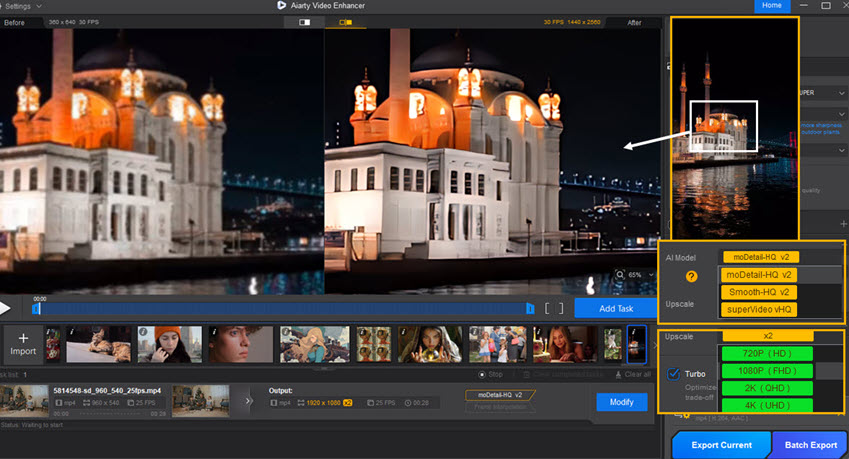
Its AI models handle tasks like upscaling, HDR rendering, and restoration, and can avoid over-smoothing of the footage. For instance, some other enhance tools may upscale realistic video to a "painterly" artificial look. Aiarty Video Enhancer offers tailored AI models for a better, more natural, 4K quality enhancement.
Canva
Still the easiest all-rounder for quick design and video tasks. Canva's AI tools handle background removal, auto resize, and style suggestions in seconds. It's perfect for creators who juggle multiple projects and don't want to open five apps just to finish a thumbnail or social post.
CapCut
CapCut's AI video editing tools are built for speed — automatic captions, filters, and scene cuts that are actually accurate. It's ideal for TikTok and YouTube Shorts creators who need professional-looking edits on the go.
Photoroom
A favorite among mobile users. Photoroom cleans up backgrounds, enhances portraits, and generates branded product photos instantly. It's like having a mini studio in your pocket.
Pixelcut
Pixelcut sits between design and photo editing. It's great for product images, banners, or social visuals with consistent lighting and shadows.
Veed
Veed Video AI brings all-in-one video editing online. It handles subtitles, templates, and AI cleanup in a simple interface that anyone can pick up in minutes.
Remini
Remini's claim to fame is AI photo restoration. It can turn pixelated or blurry faces into clear, high-quality portraits. It's a lifesaver for old family photos or low-res screenshots. For mobile users, here are more alternatives to Remini.
Remove.bg
The classic background remover that still delivers. It's clean, consistent, and ideal when you just need to isolate a subject quickly without quality loss.
Remaker
Remaker combines face swapping, image cleanup, and background tools in one workspace. It's been gaining attention for how realistic its swaps look without crossing into uncanny territory.
Loom
More of a productivity companion, Loom uses AI to help you record, share, and transcribe videos easily. For tutorials or team communication, it's still one of the most convenient ways to explain things visually.
6. 3D, Spatial Design, and AR Tools
AI is finally catching up to the 3D world. These tools help designers, architects, and creators jump from idea to visualization without needing to master complex modeling software.

Meshy AI
Meshy is one of the most user-friendly AI tools for generating 3D assets from text or images. You can type "a detailed sci-fi helmet", and Meshy outputs a textured model ready for animation or rendering. I've used it to prototype product shapes before 3D printing — it's that practical.
Spline AI
Spline is all about real-time 3D creation in the browser. The AI assistant can generate models, adjust lighting, and even animate objects automatically. It's ideal for web designers who want interactive 3D scenes without coding.
3DFY.ai
3DFY turns text prompts into fully textured 3D models, great for gaming, AR, and eCommerce. The detail level is impressive, and it's especially useful for generating product previews or concept art.
Finch 3D
A dream for architects. Finch uses AI to help generate building layouts, floor plans, and urban designs with functional logic built in. It's like having an architectural assistant who never runs out of ideas.
TestFit
More of a pro tool, TestFit helps real estate developers and planners quickly visualize building feasibility. It handles zoning, costs, and geometry automatically.
You can explore more 3D AI model generators that are catching the trend recently.
7. Voice, Music, and Audio AI Tools
Sound is the next frontier for AI creativity. Whether you're narrating videos, cloning voices, or composing original music, these tools make high-quality audio accessible to anyone.
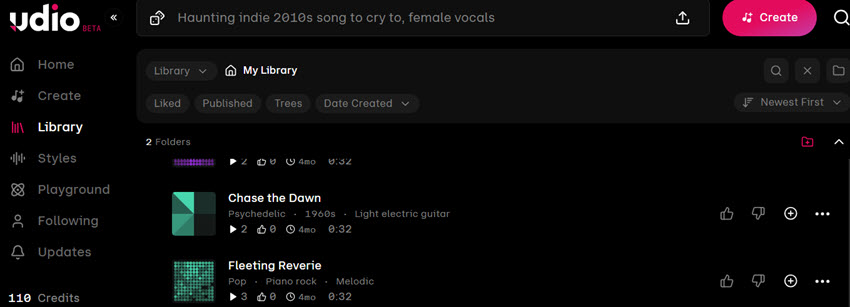
Udio
Udio focuses on professional-grade AI music production. It allows more control over structure, lyrics, and mixing than most alternatives, making it ideal for serious music creators or video producers.
Suno
Suno makes AI music composition fun and surprisingly emotional. You describe a vibe or genre, and it generates full songs, lyrics, vocals, and all. It's the fastest way to create music without touching an instrument.
ElevenLabs
As the current king of voice cloning, ElevenLabs can recreate voices with uncanny accuracy and emotion. I've used it for video voiceovers when I didn't have time to record. It's also popular among podcasters and localization teams.
Voicemod
A great choice for streamers and content creators. Voicemod turns your real-time voice into character voices, effects, or clones. It's perfect for gaming, live content, or quick comedic skits.
MusicFX
MusicFX by Google generates background tracks and loops for short videos or podcasts. It's simple but efficient. Just describe your mood, and it does the rest.
8. Search Engines and Agentic Workspaces
These tools are rethinking how we find and organize information. Instead of just search and click, they help you reason, summarize, and act. It's a big shift where AI becomes part of your daily planning.
Perplexity
The most popular AI search engine right now. It blends the accuracy of a search engine with the reasoning of an assistant, giving you sourced answers and summaries in seconds. I often use it instead of Google when researching new tech.

Flowith AI
Flowith combines a canvas-based workspace with AI integrations. You can drop in text, documents, images, and connect different models in one flow. It feels like a visual version of ChatGPT built for creators and project managers.
Quark
A sleek browser and AI search engine from China, Quark focuses on privacy and personalization. It's minimal but powerful, offering fast summaries and on-page insights.
NotebookLM
NotebookLM is Google's knowledge-grounded assistant. It lets you upload your documents and then chat with your notes directly. It's nice AI tool for writers, students, and researchers managing multiple references.
Manus
Manus is an agentic workspace that helps automate repetitive digital tasks. It connects different apps and uses AI to perform actions like creating a website for you, doing industry researches, designing a DnD role play game, etc.
9. Social Media and Marketing
For marketers and creators, these AI tools simplify everything from idea generation to trend analysis. They help you post smarter, design faster, and understand what your audience actually cares about.
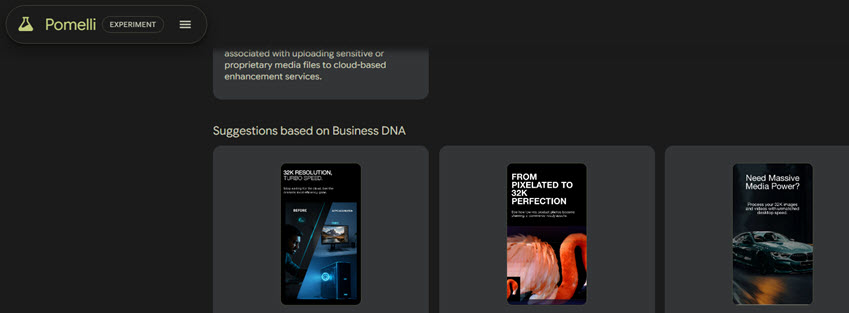
Google Pomelli
Pomelli uses AI to analyze and optimize marketing campaigns. It gives quick insights into what's performing well and where to adjust messaging. It is useful for teams managing multiple channels and keeping a brand tone.
Polybuzz
Polybuzz combines marketing analysis with sentiment tracking. It scans feedback and online chatter to show how people feel about your brand. A great companion for PR teams or anyone doing product launches.
Buffer
Still one of the most reliable social media schedulers. Its AI features now suggest captions, hashtags, and posting times. It's a time-saver for creators juggling multiple platforms.
Julius AI
Julius AI helps with influencer discovery and performance tracking. It's handy for brands trying to find genuine creators with matching audiences rather than inflated numbers.
Slidesgo
Slidesgo uses AI to generate presentation templates that fit your content style. It's surprisingly good for pitch decks and marketing visuals when you need something polished fast.
10. Writing and Notes
The writing tools category is no longer just grammar checkers and rephrasers. These AI tools help creators write faster, think better, and organize ideas in ways that feel effortless.
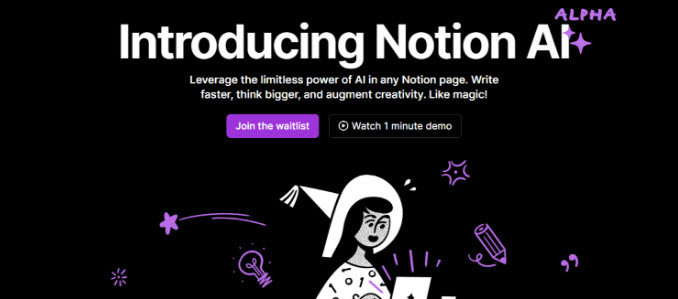
Notion AI
A powerhouse for productivity and writing combined. Notion AI helps brainstorm, summarize, and organize ideas directly inside your workspace.
Quillbot
The go-to rewriter and grammar helper. Quillbot cleans up sentences without flattening your tone, which is why it's still loved by students, bloggers, and marketers.
Jasper
Jasper is built for content marketers. It helps plan and write blog posts, ad copy, and emails at scale, keeping a consistent voice across everything.
Gamma
Gamma takes your text and turns it into beautiful, presentation-ready slides. It's one of those "how did I not know about this sooner" tools, perfect for writers who hate designing slides manually.
11. Model Hosting and Dev Platforms
For developers, researchers, or AI tinkerers, these are the playgrounds where models live, train, and evolve.
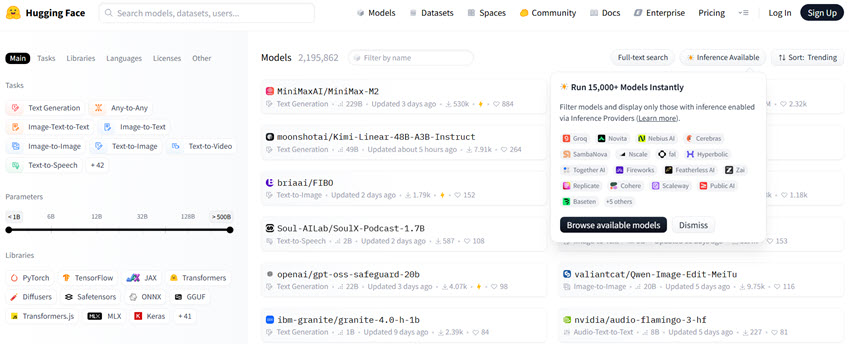
Hugging Face
As the GitHub for AI models, it's open, community-driven, and has basically become the place to find pre-trained models for everything from text generation to diffusion art. Whether you're experimenting with LLMs or testing custom pipelines, Hugging Face Spaces makes deployment easy.
If you are into Stable Diffusion image generation, you can find ControlNet models and open source Image upscalers on Hugging Face.
Google AI Studio
It's built for those who want to build, test, and refine generative AI models with Google's APIs and infrastructure. The interface is cleaner than you'd expect from a Google dev tool.
Replicate
Ideal for creators and startups who want to run AI models without setting up the backend chaos. You can deploy open models with just a few lines of code, and its pricing model keeps things transparent.
Civitai
Think of this as the "art gallery meets community lab" for Stable Diffusion models. Artists and modders upload their fine-tuned models, from anime styles to photorealistic presets, and share them openly.
Tips: You can earn credits by participating in the community, upload AI images, or post tutorials on Civitai. With those credits, you can use their on-site AI image generator, without the hassle of manually install A1111 GUI for Stable Diffusion.
Google Cloud Vertex AI
This one's for enterprise-level use. It's more about scaling and integrating AI across systems. It's ideal for teams managing pipelines, data labeling, and production deployment at scale.
12. App Builders and Vibe Coding Tools
AI app creation is getting weirdly intuitive. These tools help non-coders and coders alike build powerful apps in hours instead of weeks.
Claude
Beyond being a conversational assistant, Claude doubles as a coding companion. Its ability to read massive context windows makes it great for debugging large codebases or even generating mini web apps from specs.
Cursor
An AI-powered IDE that feels like pair programming with a genius friend. Cursor understands your codebase, explains bugs, and helps write new modules.
Windsurf
A newer player that combines multi-agent AI with visual workflows. Imagine building apps by describing logic and connecting modules instead of writing boilerplate code.
Replit
The veteran here. It's been quietly evolving into a full AI dev ecosystem, from Ghostwriter to deployment in a few clicks.
Lovable
The friendliest no-code AI app builder out there. It leans into vibe coding, where you describe what you want and it builds the prototype visually.
13. Scheduling and Task Management
Because even with AI doing half your work, time still runs out fast.

Trello
The classic board-style tool that's now infused with automation and AI suggestions. It's still great for visual thinkers who manage projects by dragging cards around.
Asana
Adds an AI layer that helps summarize project updates, predict deadlines, and flag risks automatically. For teams juggling multiple deliverables, this is a lifesaver.
Motion
For those who live in chaos, Motion's AI scheduler reorganizes your calendar dynamically. If a meeting moves, your entire week reshuffles itself.
Clockwise
Another smart calendar tool that focuses on reclaiming focus time. It automatically moves meetings to optimize for deep work.
14. Email and Communication Assistants
Inbox zero is a myth, but these tools make it less of a nightmare.
Gemini for Gmail
Suggests replies, drafts summaries, and helps you manage tone before sending. It's seamlessly integrated, which makes it more useful than standalone assistants.
Microsoft Copilot for Outlook
Another heavyweight. It pulls context from threads, attachments, and meeting notes, then helps you write professional responses in seconds.
MailButler
Adds AI writing and scheduling on top of Apple Mail and Gmail. Its analytics features are handy for people who rely on cold outreach or client updates.
SaneBox
Think of it as a personal assistant that filters your inbox for you. It automatically prioritizes important messages and tucks away distractions.
15. Detection, Filtering, and Moderation
As AI-generated content explodes, these tools play defense — helping educators, platforms, and creators verify what's real.
ZeroGPT
The most well-known AI content detector. It scans text to flag whether it's AI-written, helping teachers and content reviewers maintain transparency.
TraceGPT
A more technical option that traces generative fingerprints in text and image outputs. It's still evolving but shows promise for enterprise moderation.
Copyleaks AI Detector
Trusted by educators and publishers. It works across multiple languages and integrates into CMS systems for automated content checking.
Why These Tools Matter
Generative AI isn't about replacing people. It's about removing friction.
Whether you're speeding up research with Perplexity, building photo-real 3D assets in Meshy, composing your next track with Suno, or writing cleaner copy in Notion AI, these tools bridge the gap between ideas and execution.
We're entering a phase where the tools you pick will shape how you work, think, and create. The gap between people who simply use AI and those who understand how to use it well will grow huge this year.
So start small. Try a few from this list. Mix and match. You don't need to use them all; just find two or three that genuinely make your life easier or your work better.
Final Thoughts: Use AI, Don't Be Used by It
AI is becoming like the internet, powerful, but crowded with noise. Stick to solid, transparent tools like the ones in this guide, and you'll already be ahead of most people still scrolling through ads and limited lifetime deals.
Real AI isn't about automating creativity. It's about amplifying it. Use it to think faster, make better things, and build what actually matters to you.